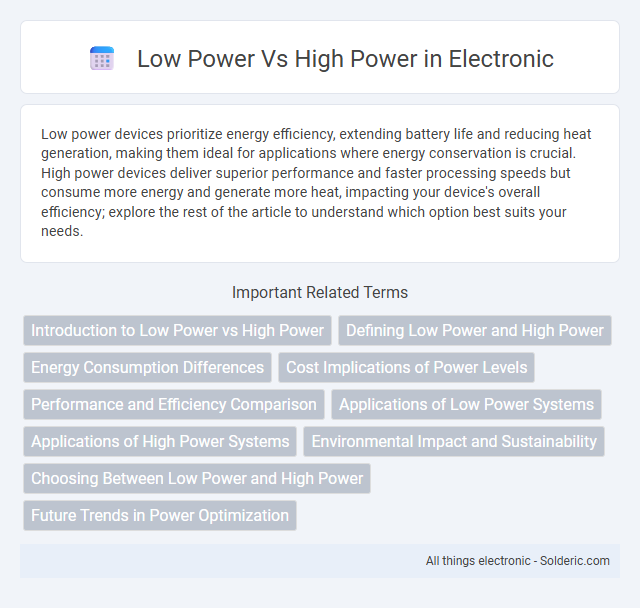Low power devices prioritize energy efficiency, extending battery life and reducing heat generation, making them ideal for applications where energy conservation is crucial. High power devices deliver superior performance and faster processing speeds but consume more energy and generate more heat, impacting your device's overall efficiency; explore the rest of the article to understand which option best suits your needs.
Comparison Table
| Feature | Low Power | High Power |
|---|---|---|
| Energy Consumption | Minimal | Significant |
| Performance | Basic | Enhanced |
| Heat Generation | Low | High |
| Battery Life | Extended | Reduced |
| Suitable Applications | Mobile Devices, IoT | Servers, High-Performance Computing |
Introduction to Low Power vs High Power
Low power systems prioritize energy efficiency by minimizing electrical consumption, extending battery life in portable devices and reducing operational costs in embedded systems. High power systems deliver greater performance and processing capabilities, essential for demanding applications like data centers, industrial machinery, and high-performance computing. Understanding the trade-offs between low power consumption and high power output is crucial for optimizing device functionality and sustainability.
Defining Low Power and High Power
Low power refers to electronic devices or systems designed to operate with minimal energy consumption, prioritizing efficiency and extended battery life. High power, in contrast, denotes devices or systems capable of delivering significant energy output, often required for performance-intensive applications like industrial machinery or high-performance computing. Understanding the balance between low power and high power helps you optimize device functionality based on energy needs and operational goals.
Energy Consumption Differences
Low power devices consume significantly less energy by operating at reduced voltage and frequency levels compared to high power devices, which require more energy to maintain higher performance outputs. This energy consumption difference translates directly into longer battery life for low power electronics, whereas high power systems often demand advanced cooling solutions to manage thermal output. Optimizing your device selection based on power requirements is crucial for balancing performance and energy efficiency.
Cost Implications of Power Levels
Low power devices generally offer lower upfront costs and reduced energy consumption, making them ideal for budget-sensitive projects or applications requiring prolonged battery life. High power devices tend to have higher initial costs due to more robust components and increased manufacturing complexity but provide superior performance and faster processing speeds. Balancing power levels with project requirements can optimize total cost of ownership by minimizing energy expenses without compromising necessary performance.
Performance and Efficiency Comparison
Low power devices prioritize energy efficiency, delivering longer battery life by operating at reduced clock speeds and voltage, while high power devices maximize performance through increased processing speed and higher thermal output. Your choice impacts tasks such as gaming, video editing, or basic web browsing, where high power systems excel in speed and responsiveness, whereas low power systems offer quieter operation and extended use without frequent recharging. Efficiency is critical for mobile and embedded applications, while performance dominates in desktop and workstation environments requiring intensive computing resources.
Applications of Low Power Systems
Low power systems are ideal for applications requiring energy efficiency and prolonged battery life, such as wearable devices, IoT sensors, and portable medical equipment. These systems reduce heat generation and operational costs while maintaining sufficient performance for tasks like data collection and wireless communication. Optimizing your device with low power technology ensures longer use and reliability in remote or mobile environments.
Applications of High Power Systems
High power systems are essential in industrial manufacturing processes, such as metal cutting, welding, and heavy machinery operation, where large energy output ensures efficiency and precision. They are also critical in power generation plants and electrical grids to transmit electricity over long distances and to meet high energy demands. In medical applications, high power lasers are used for surgical procedures and cancer treatments, providing controlled, intense energy for targeted therapy.
Environmental Impact and Sustainability
Low power devices consume significantly less energy, reducing greenhouse gas emissions and minimizing the carbon footprint associated with electronic usage. High power equipment, while often more performance-intensive, contributes to increased energy demand, leading to higher environmental impact and greater resource depletion. Choosing low power technology supports your sustainability goals by promoting energy efficiency and lowering the overall environmental burden.
Choosing Between Low Power and High Power
Choosing between low power and high power devices depends largely on your specific application needs, battery life requirements, and performance expectations. Low power options excel in energy efficiency and extended usage times, while high power devices deliver greater performance and processing capabilities, often at the expense of increased energy consumption. Assessing your priorities for longevity versus performance will guide your optimal choice.
Future Trends in Power Optimization
Future trends in power optimization emphasize the integration of advanced machine learning algorithms and adaptive power scaling to balance low power consumption with high performance demands. Emerging technologies such as energy-harvesting systems and ultra-low-power semiconductor materials enable extended battery life while maintaining computational efficiency. Your devices will benefit from smarter power management systems that dynamically adjust energy usage based on real-time workload and environmental conditions.
Low power vs High power Infographic

 solderic.com
solderic.com